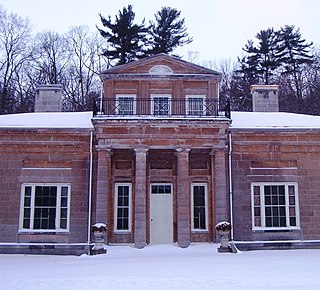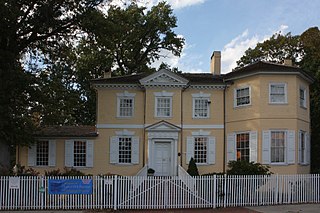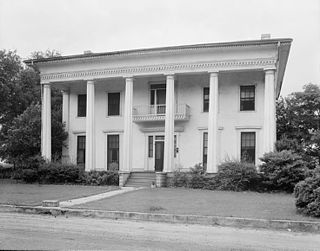Related Research Articles

Arlington House, The Robert E. Lee Memorial, formerly named the Custis-Lee Mansion, is a Greek revival style mansion located in Arlington, Virginia, United States that was once the home of Confederate Army General Robert E. Lee. It overlooks the Potomac River and the National Mall in Washington, D.C. During the American Civil War, the grounds of the mansion were selected as the site of Arlington National Cemetery, in part to ensure that Lee would never again be able to return to his home. The United States has since designated the mansion as a National Memorial. Although the United States Department of the Army controls Arlington National Cemetery, the National Park Service, a component of the United States Department of the Interior, administers Arlington House.

Vanderbilt Mansion National Historic Site is a historic house museum in Hyde Park, New York. It became a National Historic Landmark in 1940. It is owned and operated by the National Park Service.

The Josiah Quincy House, located at 20 Muirhead Street in the Wollaston neighborhood of Quincy, Massachusetts, was the country home of Revolutionary War soldier Colonel Josiah Quincy I, the first in a line of six illustrious Josiah Quincys that included three Boston mayors and a president of Harvard University.

The William Ross Rust House is a house in Tacoma, Washington, United States, built in 1905 for William Ross Rust, then President of the Tacoma Smelter and Refining Company. The house was designed by Ambrose J. Russell, who worked for Russell & Babcock with Everett Phipps Babcock, and was built by Charles Miller. Russell & Babcock also designed the Washington Governor's Mansion.

The Fulton Mansion State Historic Site is located in Fulton on the Texas Gulf Coast, in the county of Aransas, in the U.S. state of Texas. It is one of the earliest Second Empire style buildings constructed in Texas and is one of the most important of the style in the Southwest United States still in existence. Colonel George Ware Fulton and Harriet Gillette Smith began building the 4 story structure overlooking Aransas Bay in 1874 and finished in 1877. The residence, dubbed "Oakhurst" by its owners George & Harriet, featured the most up-to-date conveniences for the time, such as indoor plumbing reaching sinks in every bedroom, gas lighting and central heating, along with three bathrooms and two built-in copper tubs.

Hyde Hall is a neoclassical country mansion designed by architect Philip Hooker for George Clarke (1768–1835), a wealthy landowner. The house was constructed between 1817 and 1834, and designed with English and American architectural features. It was designated a National Historic Landmark in 1986 for its architecture, and the completeness of its architectural documentary record. It is one of the few surviving works of Philip Hooker, a leading 19th-century American architect.

The Poplar Hill Mansion is a historic U.S. mansion located at 117 Elizabeth Street, Salisbury, Maryland and is open to the public as a house museum.

Lemon Hill is a Federal-style mansion in Fairmount Park, Philadelphia, built from 1799 to 1800 by Philadelphia merchant Henry Pratt. The house is named after the citrus fruits that Pratt cultivated on the property in the early 19th century.

Randolph House is a historic mansion located in east Fairmount Park, Philadelphia, Pennsylvania. The mansion was once owned by the Philadelphia surgeon Dr. Philip Syng Physick. His daughter Sally Randolph inherited the house upon his death, at which time it became known as the Randolph Mansion, or Randolph House. The house was renamed Laurel Hill Mansion in 1976 by the City of Philadelphia during the United States Bicentennial. The central portion of the house was built around 1767 in the Georgian style and expanded in the early 19th century with a one-story addition on the south side. The octagonally-shaped Federal style addition on the north side was built in 1846.

The Anderson-Coward House, also known as Justine's Restaurant, is a historic mansion in Memphis, Tennessee, USA.

The Hunt-Phelan House is a historic mansion in Memphis, Tennessee, USA.

The Cocke-Martin-Jackson House is a historic mansion in Brandon, Mississippi, United States.

The Neibert-Fisk House, also known as Choctaw, is a historic mansion in Natchez, Mississippi, USA.

The Mansfield Cheatham House is a historic mansion in Springfield, Tennessee, U.S..

The Gilbert Mansion is a historic mansion in Nashville, Tennessee, U.S.. It was built for a Hungarian immigrant who founded Belcourt Theatre. It is listed on the National Register of Historic Places.

Dozier Farm, also known as Cliffview Farm, is a historic mansion in Nashville, Tennessee, U.S..

Carson Place, also known as the Cox-Mayfield-Sutley House, is a historic mansion in Tuscaloosa, Alabama, U.S..

Hauser Mansion is a historic house in Helena, Montana, U.S.. It was built in 1885 for Governor Samuel Thomas Hauser. It was designed by the architectural firm Wallace & Thornburg. It was inherited by his daughter, Ellen Hauser Thatcher, in 1913, and subsequently sold to the Roman Catholic Bishop of Helena, John P. Carroll, followed by other bishops. From 1935 to 1969, it was used by the Sisters of Charity of Leavenworth. It was purchased by Governor Tim Babcock in 1969. It has been listed on the National Register of Historic Places since February 12, 1979.

The Millsaps-Buie House is a historic mansion in Jackson, Mississippi, U.S.. It was built for Major Reuben Webster Millsaps, a veteran of the Confederate States Army during the American Civil War who became a wealthy cotton broker and banker after the war. It was inherited by his nephew, Webster Millsaps Buie, in 1916. The house was designed in the Queen Anne architectural style. It has been listed on the National Register of Historic Places since June 19, 1973.

Cedar Grove Mansion, located in west Fairmount Park, was the summer residence for five generations of Philadelphia families. The house was built as a rural retreat from city life, and was originally located within the present day Frankford neighborhood of Northeast Philadelphia, about 4 mi (6.4 km) beyond the colonial-era city limits. In 1746, Elizabeth Coates Paschall purchased the property on which the house was subsequently built. Paschall was a widow with three children who had inherited her husband's dry goods business and desired a rural retreat from the city near her father's farm in Frankford. Construction of the grey stone house on a plot of 15 acres (6.1 ha) along Frankford Road began in 1748 and continued to 1750.
References
- ↑ "National Register Information System". National Register of Historic Places . National Park Service. July 9, 2010.
- 1 2 3 4 5 6 "National Register of Historic Places Inventory--Nomination Form: Webster, George House or Babcock House". National Park Service. Retrieved January 11, 2016.
- ↑ "Webster, George, House". National Park Service. Retrieved January 11, 2016.